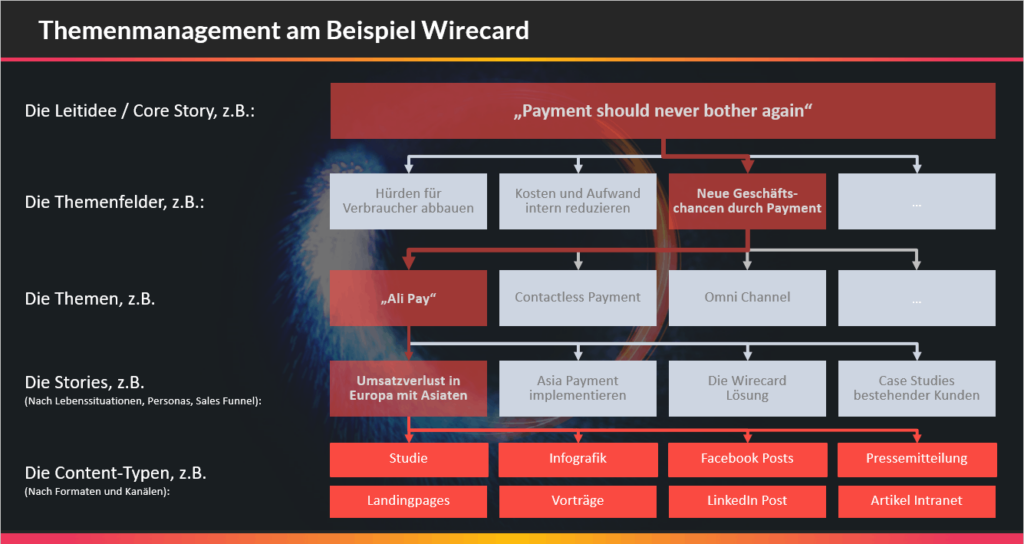Content Strategie: Von der Marketing-Technik zur Management-Disziplin

Wer Content-Marketing nur als eine Online-Marketing-Disziplin sieht, hat das Potenzial von „Content“ nicht erkannt. Über kurz oder lang muss jede Art von Marketing den immer höheren Ansprüchen von immer aufmerksamkeits-beschränkteren Konsumenten gerecht werden. Um das disziplinübergreifend zu leisten, braucht es einen grundsätzlichen Wandel. Nicht nur in der Ausrichtung der Content-Strategie, sondern im Marketing- und Kommunikations-Management schlechthin.
Ob Content-Shock, Medienwandel und Werbeablehnung, oder die immer lautere, hyperventilierende Empörungsmaschinerie in Social Media und im Boulevard: Die Marketing-Welt wandelt sich gerade fundamental. Die Folge: Konsumenten werden taub gegenüber Marketingaktionen, die nicht authentisch und relevant sind. Fünfundsiebzig der einhundert besten globalen Verbrauchermarken werden bis 2020 zwanzig Prozent ihres Markenwerts durch sinkende Markenwahrnehmung und ‑loyalität verlieren, prognostiziert das Marktforschungsunternehmen Gartner. Das betrifft aber nicht nur globale Marken. Kleinere Marken wird es potenziell noch viel härter treffen. Das gilt für B2B ebenso wie für B2C. Und die Frage ist: Wie geht man damit um?
Es trifft uns in unserer täglichen Arbeit
Die Menschen, die im Marketing und in der Kommunikation arbeiten, sind aktuell nicht zu beneiden: Ständig neue Formate, neue Plattformen, immer neue Hype-Themen, der immer größer werdenden Druck, überall einen direkten ROI nachzuweisen. Wir hetzen von einer Disziplin zur anderen. Und der Markt sowie die internen Stakeholder treiben uns vor sich her. Jedes Thema ist wichtig, alles muss sofort umgesetzt werden. Und wenn etwas nicht funktioniert, noch mehr Druck wird es schon richten. Anstatt anzuhalten und uns zu fokussieren, verlieren wir uns leicht in Aktionismus, nur um irgendwie die KPIs zu erfüllen: Klicks, Traffic, Likes, Shares, Hechel, Hechel. Und was macht das mit uns? Wie gehen wir damit um?
Das PISSSED Modell: Die verzweifelte Suche nach dem einfachen Ausweg
Und so treibt das Marketing auf der Suche nach der richtigen Strategie so manch skurrile Blüte: Bemühungen, durch Influencer Marketing wenigstens noch ein paar Menschen in der Zielgruppe zu erreichen, muten schon mächtig verzweifelt an. Gleiches gilt für viele unbeholfene Versuche über Native Advertising, wenn die plattesten Werbebotschaften in ein neues Gewand gepackt werden, und alle denken: Merkt bestimmt keiner. Stimmt aber nicht. Merkt doch jeder. Und fragt sich: Haben die einen an der Klatsche?
Andere retten sich in ihren Silo und suchen Halt und Übersicht in ihrem kleinen (Be-)Reich. Und wieder andere suchen ihr Heil in Daten. Sie verheißen, unsere Kunden individueller und persönlicher ansprechen zu können, und das verspricht die Steigerung der Relevanz und damit eine wieder höhere Beachtung. Das wäre es doch!

Die Ursache für das Scheitern ist der Content, nicht die Daten
Daten haben Potenzial, das steht außer Frage. „Bis zum Jahre 2020 werden 90 Prozent aller Unternehmen mindestens eine Form von (datenbasierter) Marketing-Automatisierung nutzen“, hat Gartner herausgefunden. Allerdings kommt Gartner noch zu einem anderen, sehr interessanten Schluss: Bei all den Bemühungen um Daten seien die Daten gar nicht das Problem, sondern der Content: Er sei der Engpass und die Hauptursache für ein Scheitern, nicht die Daten.
Denn selbst wenn Unternehmen die besten Kundendaten der Welt haben, haben sie immer noch nicht die ausreichenden Inhalte, um die Erwartungen der Kunden zu erfüllen. Und am Ende gilt das eben auch wieder für alle Disziplinen, für Influencer Marketing und Native Advertising und für Social Media und für E‑Mails und für alles andere auch. Ohne King Content ist eben Queen Distribution gar nichts wert. Wie kann dann „Content Marketing“ eine eigene Disziplin sein, vielleicht sogar eine eigene Abteilung, also wieder ein Silo? Also wenn alle Content brauchen?
Relevant bleibt nur, wer Erwartungen befriedigt
Wer also einen Schritt weiterdenkt, braucht nicht einfach nur irgendeine Content-Strategie: Sie muss vielmehr konsequent darauf abzielen, der Zielgruppe einen Nutzen zu bieten. Entsprechend ihrer individuellen Bedürfnisse und entsprechend der jeweiligen Situation. Dabei ist es egal, über welchen Kanal das passiert. „Content“ ist dann auch nicht nur der Beratungs-Beitrag im „Upper Funnel“, sondern auch die Produktinformation im „Lower Funnel“. Denn irgendwann braucht der Interessent nämlich auch darüber Informationen. Beide gehören sie zu einem Team. Und gewinnen kann das Team nur, wenn alle bestmöglich zusammenspielen und bestmöglich vernetzt sind. Auch hier: „La Mannschaft“. Und das Spielsystem.
Es kommt also nicht darauf an, einfach nur viele neue Content-Formate zu erstellen und die dann im jeweiligen Silo (aka Kanal) möglichst groß zu distribuieren. Es kommt darauf an, die immer spezifischer werdende Kundenbedürfnis individuell zu befriedigen. Oder genauer: Sie besser zu befriedigen, als es der Wettbewerb tut. Dann ist es ein Wettbewerbsvorteil. Wer das als Unternehmen nicht schafft, dem gegenüber werden die Konsumenten taub.
Don’t think more. Think better.
In der Praxis ist das aber leichter gesagt als getan. Das liegt insbesondere auch daran, dass alle eine andere Auffassung, was eigentlich „guter“ Content ist. SEO anders als Corporate Publishing, Social Media anders als die Unternehmenskommunikation, E‑Mail-Marketing anders als E‑Commerce usw. Und so macht jeder eben das, war er für richtig findet und jeder arbeitet wieder nebeneinander her. Customer Journey und Touchpoint Management haben kaum eine Chance berücksichtigt zu werden, außer mal in Kampagnen. Die Konsequenz ist ein zunehmender Aktionismus, eine zunehmende Abkoppelung der Bereiche, Doppelarbeit, unterbrochene Conversion Funnels und damit steigende Kosten und sinkende Effektivität.
Der „Newsroom“ soll es richten
Ein Ansatz, dieser Problematik Herr zu werden und vor allem auch Silos einzureißen ist der Corporate Newsroom. Vordergründig ist das ein Großraumbüro, in dem die unterschiedlichen Disziplinen gemeinsam arbeiten, gegebenenfalls auch nur einige „Abgesandte“ der Kanäle und Disziplinen. Die Fürsprecher für diesen Newsroom setzen hier auf die räumliche Nähe und täglich zum Teil mehrfach stattfindende, kurze Meetings, „Stand-up“ genannt. Die auffälligsten Elemente sind ein großer Stehtisch (an dem eben die „Stand-ups“ abgehalten werden, deswegen muss es ein Stehtisch sein) sowie große Monitore an der Wand, die in Echtzeit Daten liefern. Dahinter stehen noch eine Reihe neuer Prozesse und eine andere Organisation.
Von der Kanal- zur Themenstrategie
Dabei fragt man sich immer wieder neu, wie man ein Thema oder eine untergeordnete Story im Interesse der adressierten Zielgruppe spielen muss: Mit welchen Content-Formaten, mit welcher Dramaturgie, in welchen Kanälen, mit welcher Substanz usw. Und erst, wenn das für das Thema bzw. die Story und über alle Disziplinen hinweg definiert wurde, übergeben die Themen-Manager, die diesen Prozess koordinieren, an die Kanal-Manager, die dann im Einklang mit allen anderen den Content für ihren Kanal fertigstellen und distribuieren.

Mit Excel geht das nicht
Diese Art von Organisation bringt aber noch eine Neuerung mit sich, nämlich Software-Plattformen, welche diesen „physischen Newsroom“ quasi virtuell abbilden, aber – noch viel wichtiger – die Prozesse organisieren und die Transparenz herstellen, die ein physischer Newsroom allein gar nicht leisten kann.
Das diese Content Marketing Plattformen heute eine Schlüsselrolle spielen, zu diesem Ergebnis ist auch eine Studie des CMF im Frühjahr 2018 gekommen. Wer sich aber in diesem Tool-Markt umschaut, wird sich ebenso leicht verirren, wie Hänsel und Gretel im dunklen Wald. Zu generisch werden Begriffe wie „Content“ und „Content Marketing“ verwendet. Oftmals sind es eben wieder nur Silo-Lösungen, wie zum Beispiel beim Anbieter Content Bird, die sehr auf die Bedürfnisse von SEO ausgerichtet sind. Oder Dirico, die aus dem Social-Media-Management kommen. Ähnliches gilt für MyNewsdesk, deren man die Herkunft aus der klassischen PR stark anmerkt, oder für Hubspot, die sich vor allem dem Performance-Marketing verpflichtet haben. Das sind alles hervorragende Tools. Es besteht allerdings die Gefahr, dass man hier schnell an Grenzen mit Blick auf die oben beschriebene Aufgabe stößt. Das ist keine Schwäche, im Gegenteil. Nur für die übergeordnete Organisation sind sie dann womöglich nicht perfekt geeignet.
Es braucht ein Umdenken
Vor allem braucht es ein Umdenken, nämlich von einem kanalzentrierten hin zu einem themenzentrierten Arbeiten. Der Wechsel von einer Kanal- zu einer Themenstrategie besteht vor allem darin, dass man zunächst eine Themenstruktur entwickelt, und zwar aus einem zentralen Narrativ heraus, welche Quasi die Positionierung des Unternehmens ist, und das sehr viel mit der Marke gemein hat. Dann werden Themenfelder und Themen für das ganze Jahr definiert. Was in der Jahresplanung noch grob ist, wird schrittweise in der Quartals‑, Monats- und ggf. Wochenplanung konkretisiert, wozu jeweils Gesamt-Redaktionsmeetings stattfinden. So stellt man sicher, dass auch immer aktuelle Geschehnisse berücksichtigt werden, ohne dabei den roten Faden zu verlieren.
Eher geeignet sind hier die großen amerikanischen Plattformen wie Percolate, Kapost, Newscred oder Opal, die genau für den Zweck entwickelt wurden. Sie haben allerdings auch den Nachteil, dass die Server oft nur in den USA stehen, was wieder datenschutzrechtlich bedenklich ist. Hierfür muss man schauen: Einige dieser Firmen bieten auch an, die Plattformen „on premises“ zu installieren, also auf unternehmensinternen Servern. In Deutschland ist derzeit vor allem Scompler, das Unternehmen des Autors, aktuell ausgesprochen erfolgreich. Wie kein anderes integriert es ein Themenmanagement und Content Strategie in die täglichen Arbeitsabläufe.
Die 7 Kernfaktoren einer modernen Content-Marketing-Organisation
Diese 7 Faktoren sind keine hinreichenden, aber sicher notwendige Bedingung, um seine Organisation fit für den digitalen Wandel und die Zukunft zu machen:
- Themen- anstatt Kanalstrategie: Es geht nicht darum, Kanäle zu betreiben oder zu befüllen, sondern Themen crossmedial bestmöglich zu bespielen und so die Bedürfnisse der Zielgruppen individuell und konsequent zu erfüllen.
- Themenscoring und Themenscoping: Anstatt über jedes Stöckchen zu springen und möglichst viele Themen zu bespielen, müssen Unternehmen ihre Themen je nach Wichtigkeit unterschiedlich intensiv bespielen. Dafür braucht es ein Scoring der Themen nach einer fixen Methodik.
- Storyboarding: Bei den wichtigen Themen muss das Thema in vielen Varianten für unterschiedliche Personas und Phasen im Conversion Funnel aufbereitet werden.
- Atomisierter Content: Content muss zunächst kanalneutral erstellt und dann später für jeden relevanten Kanal aufbereitet werden.
- Agile Content-Strategie: Moderne Unternehmen entwickeln auch die Content-Strategie nach demPrinzip „Agil“ und „MVP“ (Minimum Viable Product). Die Content-Strategie muss genau so viel enthalten, dass die im Content-Prozess auftauchenden Fragen gemeinsam für das ganze Team beantwortet werden – und mehr nicht. Tauchen neue Fragen auf, werden sie dann in die Strategie aufgenommen.
- Themenmanager: Typisch für diese Art von Organisation ist die Rolle des Themenmanagers. Er (oder sie) übernimmt die Leitung bei der Organisation und der Ausarbeitung der Themen und ihrer Stories. Zur eigentlichen Content-Erstellung und Distribution übergibt sie dann wieder an die Kanal-Manager. So werden Silos nicht eingerissen aber durchlässig gemacht und koordiniert.
- Zentrale Content-Plattform: Von entscheidender Bedeutung ist eine zentrale Content-Plattform, auf der alle Kommunikations-Disziplinen jeglichen Content für alle transparent managen. Das muss zunächst eine „virtuelle Plattform“, also eine Software sein, ggf. auch der physische Newsroom.